One to one maths interventions built for KS4 success
Weekly online one to one GCSE maths revision lessons now available
In order to access this I need to be confident with:
Square numbers Expand and simplify Rearranging equations Fraction arithmeticThis topic is relevant for:

Completing The Square
Here is everything you need to know about completing the square for GCSE maths (Edexcel, AQA and OCR). You’ll learn how to recognise a perfect square, complete the square on algebraic expressions, and tackle more difficult problems with the coefficient of
You will also learn how to solve quadratic equations by completing the square, and how the completed square form links to graphs of quadratic equations.
Look out for completing the square worksheets and exam questions at the end.
What is completing the square?
A quadratic expression like
This is because it factorises to give
We can see this idea diagrammatically as follows:
Most quadratic expressions are not perfect squares, and cannot be written in this form as a single squared bracket. When we complete the square, we try to fit the expression to the closest possible perfect square, with a little bit added or subtracted to make things work.
Some expressions will have an ‘extra’ amount over from a perfect square, such as:
So we would write this expression in completed square form as:
Some expressions will be ‘missing’ an amount to make a perfect square, such as:
So we would write this expression in completed square form as:
While it’s easy to see this using diagrams for quadratic expressions with small coefficients, we need a better method for expressions with larger coefficients. You may have noticed already that we divide the coefficient of
Completing the square is a really useful method for solving quadratic equations; the quadratic formula for solving quadratic equations is based on it and can be derived by completing the square.
The completed square form of a quadratic expression is also really useful for identifying key points of quadratic functions, such as the maximum or minimum of a quadratic parabola (also called the vertex), without having to draw a graph. You can see this in the examples below.
You may sometimes see an expression in the form
What is completing the square?
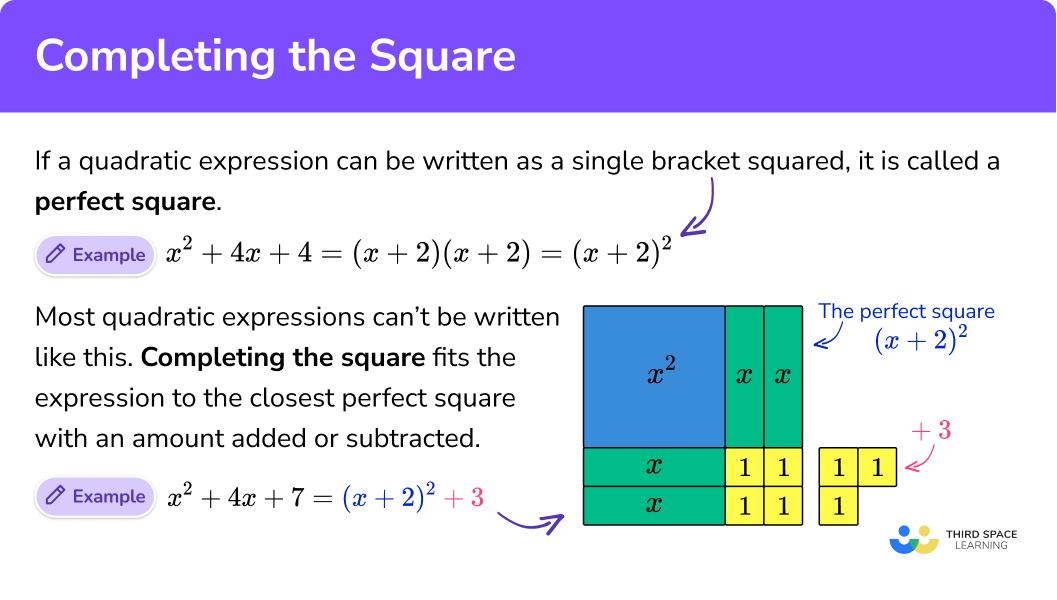
How to complete the square
In order to complete the square:
- Find the closest perfect square by dividing the coefficient of
x by2 . - Expand the perfect square expression.
- Compare the constant term in the perfect square to the original expression, and adjust as needed.
Explain how to complete the square in 3 steps
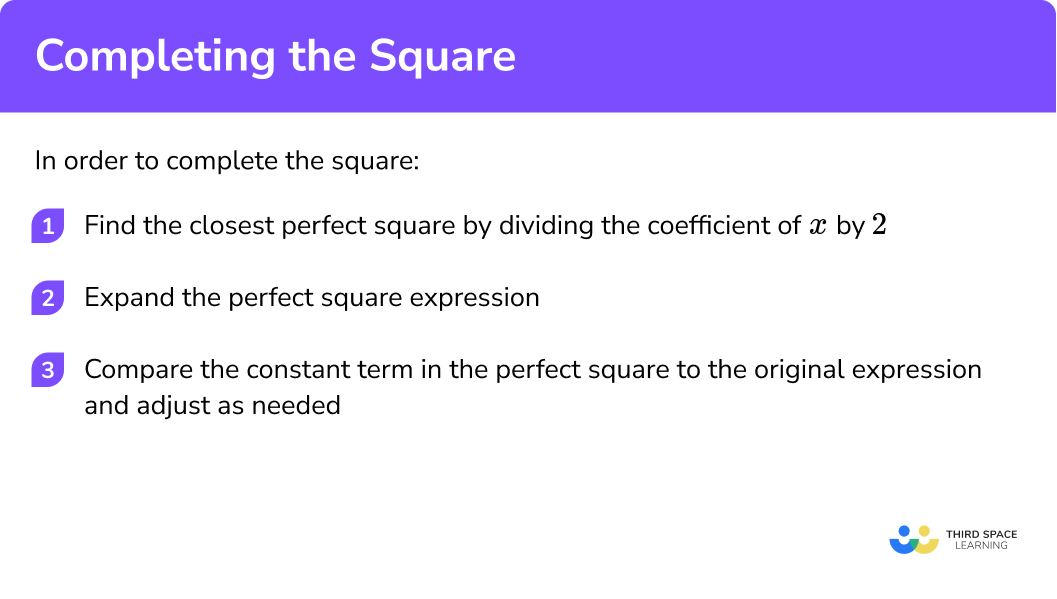
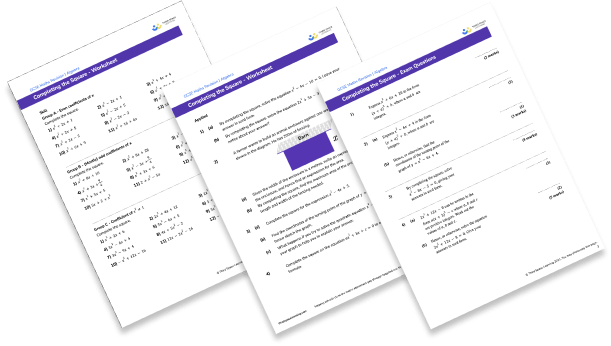
Completing the square worksheet

Get your free completing the square worksheet of 20+ questions and answers. Includes reasoning and applied questions.
DOWNLOAD FREE
Completing the square worksheet

Get your free completing the square worksheet of 20+ questions and answers. Includes reasoning and applied questions.
DOWNLOAD FREERelated lessons on quadratic equations
Completing the square is part of our series of lessons to support revision on quadratic equations and solving equations. You may find it helpful to start with the main solving equations lesson for a summary of what to expect, or use the step by step guides below for further detail on individual topics. Other lessons in this series include:
Completing the square examples
Example 1: perfect square
Complete the square for the expression
- Find the closest perfect square by dividing the coefficient of
x by2 .
The coefficient of
The closest perfect square is:
2 Expand the perfect square expression.
3 Compare the constant term in the perfect square to the original expression, and adjust as needed.
These match (because our example was a perfect square), so we don’t need to make any adjustment.
The answer in complete square form is
Graphically
This graph shows the curve
The minimum value of
If we substitute
So the coordinates of the vertex, which is a minimum point, are
Example 2: simple case with coefficient of x2 = 1 and an even, positive coefficient of x
Complete the square for the expression
Find the closest perfect square by dividing the coefficient of x by 2.
The coefficient of
The closest perfect square is
Expand the perfect square expression.
Compare the constant term in the perfect square to the original expression, and adjust as needed.
In order to make the constant term correct, we need to add
The answer in complete square form is
Graphically
This graph shows the curve
The minimum value of
If we substitute
So the coordinates of the vertex, which is a minimum point, are
As a little shortcut, the
Example 3: another simple case with coefficient of x2 = 1 and an even, positive coefficient of x
Complete the square for the expression
Find the closest perfect square by dividing the coefficient of x by 2.
The coefficient of
The closest perfect square is
Expand the perfect square expression.
Compare the constant term in the perfect square to the original expression, and adjust as needed.
In order to make the constant term correct, we need to subtract
The answer in complete square form is
Graphically
This graph shows the curve
The minimum value of
If we substitute
So the coordinates of the vertex, which is a minimum point, are
Example 4: coefficient of x2 = 1 and a negative coefficient of x
This is really straightforward – just remember that your perfect square bracket will need subtraction rather than addition in the middle.
Complete the square for the expression
Find the closest perfect square by dividing the coefficient of x by 2.
The coefficient of
The closest perfect square is
Expand the perfect square expression.
Compare the constant term in the perfect square to the original expression, and adjust as needed.
In order to make the constant term correct, we need to subtract
The answer in complete square form is
Graphically
This graph shows the curve
The minimum value of
If we substitute
So the coordinates of the vertex, which is a minimum point, are
Example 5: coefficient of x2 = 1 and an odd coefficient of x
Complete the square for the expression
Find the closest perfect square by dividing the coefficient of xby 2.
The coefficient of
It can be tempting to use decimals, but fractions are much easier, particularly as completing the square is more likely to be examined on a non-calculator paper at GCSE.
The closest perfect square is
Expand the perfect square expression.
Compare the constant term in the perfect square to the original expression, and adjust as needed.
It can be useful to think of
this makes it easier to work out the adjustment.
In order to make the constant term correct, we need to add
because
The answer in complete square form is
Graphically
This graph shows the curve
The minimum value of
If we substitute
we get:
So the coordinates of the vertex, which is a minimum point, are
How to complete the square when coefficient of x2 is not 1 ²
If the coefficient of
- Factorise.
- Complete the square on the expression inside the brackets: find the closest perfect square by dividing the coefficient of
x by2 . - Expand the perfect square expression.
- Compare the constant term in the perfect square to the original expression, and adjust as needed.
- Multiply out the factorised value.
How to complete the square when coefficient of x² is not 1
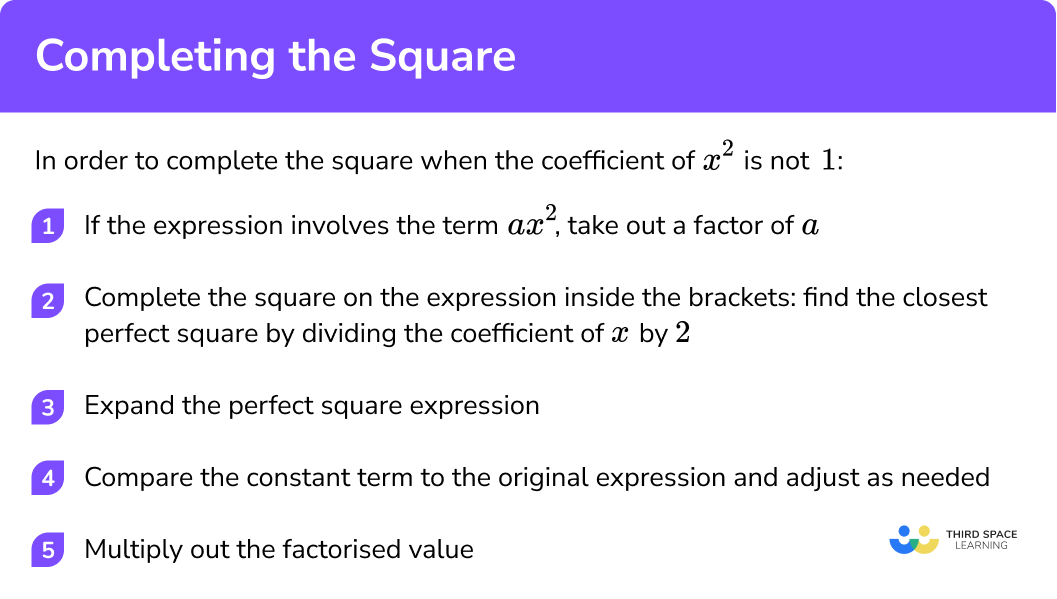
Completing the square when coefficient not 1 example
Example 6: coefficient of x2 ≠ 1
Complete the square for the expression
Factorise.
We take out the common factor of
then complete the square on the expression inside the bracket.
Find the closest perfect square by dividing the coefficient of x by 2.
The coefficient of
The closest perfect square is
Expand the perfect square expression.
Compare the constant term in the perfect square to the original expression, and adjust as needed.
In order to make the constant term correct, we need to subtract
So the expression in complete square form is
Multiply out the factorised value.
Don’t forget to deal with the factor of
in complete square form is:
Finally, expand out to give a final answer:
Graphically
This graph shows the curve
The minimum value of
If we substitute
So the coordinates of the vertex, which is a minimum point, are
Note: we can also complete the square for expressions with a negative
For example,
would be written as:
and then completed as in Example 5.
How to solve quadratic equations using completing the square
Some quadratic equations can be solved by factorising, but most require either completing the square or the quadratic formula – in fact, the quadratic formula is derived from completing the square (see worksheet).
In order to solve quadratic equations using complete the square:
- Make sure the equation is rearranged so that the right hand side equals
0 (if necessary). - Complete the square on the left hand side.
- Rearrange and solve the resulting equation for
x .
How to solve quadratic equations using completing the square
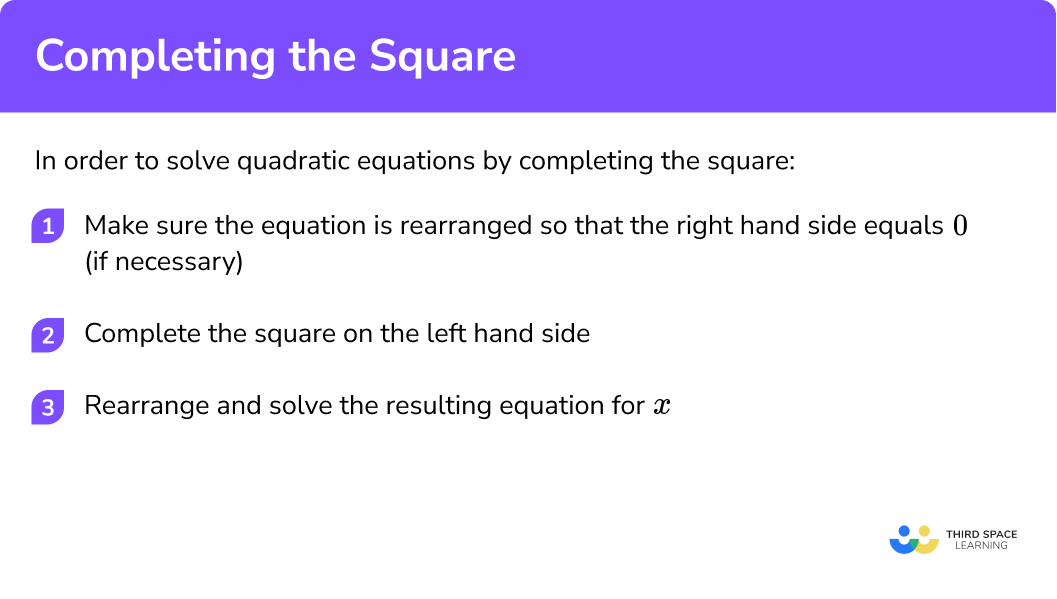
Solving using completing the square method examples
Example 7: solving a quadratic by completing the square
Solve the quadratic equation
Make sure the equation is rearranged so that the right hand side equals 0 (if necessary).
RHS already equals
Complete the square on the left hand side.
Rearrange and solve the resulting equation for x.
We have two solutions to the equation:
It is really important to remember the
In most cases, your answer should be left in surd form (with the square root sign in), not converted to a decimal.
Example 8: solving a harder quadratic by completing the square
Solve the quadratic equation
Make sure the equation is rearranged so that the right hand side equals 0 (if necessary).
Rearrange by adding
Complete the square on the left hand side.
Remember to take out a common factor of
Rearrange and solve the resulting equation for x.
We have two solutions to the equation:
Common misconceptions
- Incorrect sign in the middle of the perfect square bracket
The sign will always be the same sign as the coefficient of
- Errors with fraction arithmetic
In particular, remember to square the numerator and denominator when squaring a fraction.
- Going the wrong way when working out the adjustment
Remember to always work out how you get from the perfect square to the expression in the question.
- Forgetting the ± sign when using the completing the square method to solve quadratics
Check carefully to make sure you haven’t lost one of your solutions!
Practice completing the square questions
1. Complete the square:
x^{2} + 12x + 36




Half the coefficient of x is 6 so it is (x+6)^{2} .
Expanding (x+6)^{2}. gives us x^{2}+12x+36 so we do not need to add or subtract anything.
2. Complete the square:
x^{2}+6x+2




Half the coefficient of x is 3 so it is (x+3)^{2} .
Expanding (x+3)^{2} gives us x^{2}+6x+9 so we need to subtract 7 which gives us (x+3)^{2} -7 .
3. Complete the square:
x^{2}-5x+12




Half the coefficient of x is \frac{5}{2} so it is (x-\frac{5}{2})^{2} .
Expanding (x-\frac{5}{2})^{2} gives us x^{2}-5x+\frac{25}{4} .
We need +12 , which is the same as + \frac{48}{4} so we need to add \frac{23}{4} .
Therefore the answer is (x-\frac{5}{2})^{2} + \frac{23}{4} .
4. Complete the square:
-2x^{2}-4x+14




We must first take a factor of -2 out to get -2(x^{2}+2x-7) .
We then need to complete the square for x^{2}+2x-7 .
This gives us (x+1)^{2}-8 .
So the final answer is -2[(x+1)^{2}-8]=-2(x+1)^{2}+16 .
5. Find the coordinates of the minimum point of the function:
y=x^{2}-6x+1




We need to start by completing the square. This gives us y=(x-3)^{2}-8 .
We can then see that the minimum point is when (x-3) = 0 so x=3 .
Substituting this in gives us y=0^{2}-8=-8. .
Therefore the minimum point is (3, -8) .
6. By first completing the square, find the solutions to the equation:
x^{2}+8x+3=0




Completing the square gives us (x+4)^{2}-13 .
Therefore we need to solve:
\begin{aligned} (x+4)^{2}-13&=0\\\\ (x+4)^{2}&=13\\\\ x+4&=\pm \sqrt{13}\\\\ x&= -4 \pm \sqrt{13} \end{aligned}Completing the square GCSE questions
1. x^{2}+12x+19 can be written in the form
(x+a)^{2}+b where a and b are integers.
Work out the values of a and b .
(2 marks)
(1)
b = −17(1)
2. (a) x^{2}-6x+7 can be written in the form
(x+a)^{2}+b where a and b are integers.
Work out the values of a and b .
(b) Hence, or otherwise, solve the equation
x^{2}-6x+7=0Give your answers in surd form.
(4 marks)
(a)
a = −3(1)
b = −2(1)
(b)
x = 3 + \sqrt{2}(1)
x = 3 − \sqrt{2}(1)
3. (a) 3x^{2}+12x-18 can be written in the form
a(x+b)^{2}+c where a and b are integers.
Work out the values of a, b and c .
(b) Hence, or otherwise, find the coordinates of the turning point of the graph of y=3x^{2}+12x-18
(4 marks)
(a)
a = 3(1)
b = 2(1)
c = −30(1)
(b)
(−2, −30)(1)
Learning checklist
You have now learned how to:
- Complete the square for a quadratic expression
- Solve quadratic equations by completing the square
- Identify turning points by completing the square
The next lessons are
Still stuck?
Prepare your KS4 students for maths GCSEs success with Third Space Learning. Weekly online one to one GCSE maths revision lessons delivered by expert maths tutors.

Find out more about our GCSE maths tuition programme.